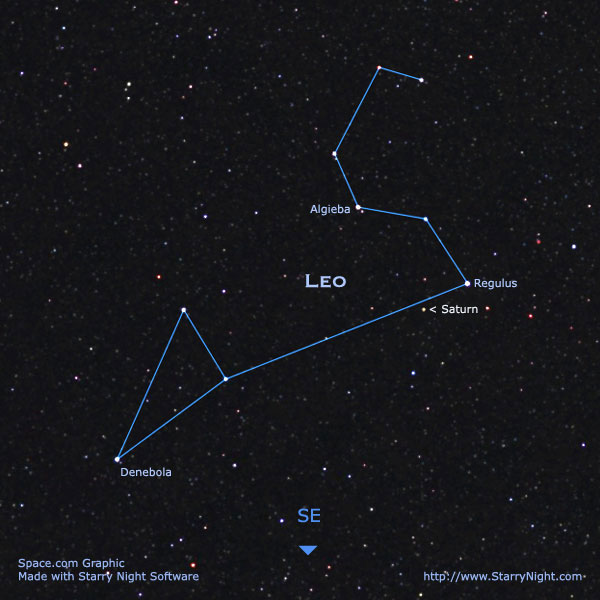Inside Leo the Lion

We're now more than a week into the spring season (even if,meteorologically, in some parts of the country it's still very much wintry),and high in our current evening sky the most famous stars of spring are to befound making up the constellation of Leo, the Lion.
The most noteworthy star of this distinctive pattern is thebluish-white Regulus. According to Richard HinckleyAllen (1838-1908), an expert in stellar nomenclature, this star was known in Arabia as Malikiyy — "thekingly one." Yet, Regulus was seemingly alwaysassociated in ancient cultures with royalty and kingly power. Copernicus hasbeen credited with giving the star its present name, a diminutive of Rex, orking, which may also relate to the four so-called "Royal Stars" (withAldebaran, Antares and Fomalhaut) all situated about 90 degrees apart on the sky.
As the brightest star in Leo, first magnitude Regulus has been almost universally associated in ancientcultures with the concept of royalty and kingly power. This star lies in thehandle of the so-called "Sickle of Leo," a star pattern resembling alarge reversed question mark. Regulus is 77 lightyears distant; meaning that the light you see emanating from it tonight startedon its journey toward Earth back in 1931, when Herbert Hoover was U.S.President, and Spain became a republic with the overthrow of King Alfonso XIII.The diameter of Regulus is estimated to be about fivetimes that of the Sun; its luminosity160 times greater.
Algeiba ("the Lion'sMane") is in the curve or the blade of the Sickle, and appears as a singlestar to the naked eye. However, as a telescope of only moderate size willclearly show, it is really one of the most beautiful double stars in the sky.It should really be observed in twilight or bright moonlight to reveal thecontrasting colors ? one star has been said to be greenish, the other adelicate yellow. Others, however, have described different hues such as paleyellow and orange; reddish and golden yellow and even pale red and white!
The Sickle, when rising and climbing the sky, as it is doingnow, is seen cutting upward. This year, there is also planetary interlopernearby in yellowish-white Saturn.Located to the left (east) of Regulus and shiningmore than twice as bright, Saturn is always a show stopper with its spectacularring system, visible even in a small telescope.
Eastward from the Sickle there is a right triangle of starsthat also belong to Leo. At the eastern point of this triangle you will find Denebola ("The Lion's Tail"). To modern skywatchers the Sickle outlines the majestic head and mane of a greatwestward-facing lion, with the triangle forming the lion's forequarters. He iscrouching in the regal pose somewhat resembling the enigmatic Sphinx.Astronomer Henry Neely (1879-1963), for many years a popular lecturer at New York's HaydenPlanetarium, would often use his electric pointer to draw attention to thesestars and then would exclaim: "Behold! Here is the lion known as Leo. Aconception that was familiar to the peoples of many lands long before a certainmotion-picture company adopted him as its trademark."
- Online Sky Maps and More
- Sky Calendar & Moon Phases
- Astrophotography 101
Joe Rao serves as an instructorand guest lecturer at New York'sHayden Planetarium. He writes about astronomy for The New York Times and otherpublications, and he is also an on-camera meteorologist for News 12 Westchester, New York.
Breaking space news, the latest updates on rocket launches, skywatching events and more!
Join our Space Forums to keep talking space on the latest missions, night sky and more! And if you have a news tip, correction or comment, let us know at: community@space.com.

Joe Rao is Space.com's skywatching columnist, as well as a veteran meteorologist and eclipse chaser who also serves as an instructor and guest lecturer at New York's Hayden Planetarium. He writes about astronomy for Natural History magazine, Sky & Telescope and other publications. Joe is an 8-time Emmy-nominated meteorologist who served the Putnam Valley region of New York for over 21 years. You can find him on Twitter and YouTube tracking lunar and solar eclipses, meteor showers and more. To find out Joe's latest project, visit him on Twitter.
